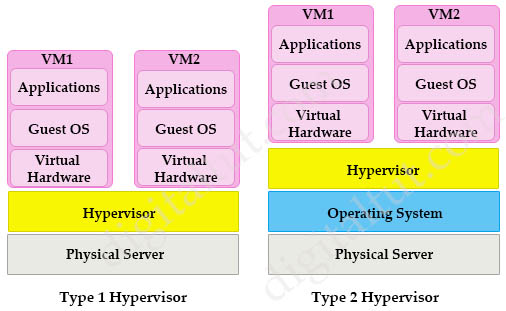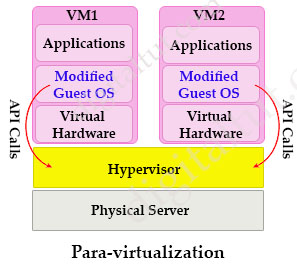Hypervisor type 1 and 2 Tutorial
A virtual machine (VM) is a software emulation of a physical server with an operating system. From an application’s point of view, the VM provides the look and feel of a real physical server, including all its components, such as CPU, memory, and network interface cards (NICs).
A hypervisor, also known as a virtual machine monitor, is a software that creates and manages virtual machines. A hypervisor allows one physical server to support multiple guest VMs by virtually sharing its resources, such as memory and processing.
There are two types of hypervisors: type 1 and type 2 hypervisor.
In type 1 hypervisor (or native hypervisor), the hypervisor is installed directly on the physical server. Then instances of an operating system (OS) are installed on the hypervisor. Type 1 hypervisor has direct access to the hardware resources. Therefore they are more efficient than hosted architectures. Some examples of type 1 hypervisor are VMware vSphere/ESXi, Oracle VM Server, KVM and Microsoft Hyper-V.
In contrast to type 1 hypervisor, a type 2 hypervisor (or hosted hypervisor) runs on top of an operating system and not the physical hardware directly. A big advantage of Type 2 hypervisors is that management console software is not required. Examples of type 2 hypervisor are VMware Workstation (which can run on Windows, Mac and Linux) or Microsoft Virtual PC (only runs on Windows).

Comparison Type 1 and Type 2 hypervisors
| Type 1 hypervisor | Type 2 hypervisor | |
| Other name | Bare metal hypervisor | Hosted hypervisor |
| Runs on | Underlying physical host machine hardware | Underlying operating system (host OS) |
| Best suited for | Large, resource-intensive, or fixed-use workloads | Desktop and development environments |
| Can negotiate dedicated resources? | Yes | No |
| Knowledge required | System administrator-level knowledge | Basic user knowledge |
| Examples | VMware ESXi, Microsoft Hyper-V, KVM | Oracle VM VirtualBox, VMware Workstation, Microsoft Virtual PC |
Structure of virtualization in a hypervisor
Hypervisors provide virtual switch (vSwitch) that Virtual Machines (VMs) use to communicate with other VMs on the same host. The vSwitch may also be connected to the host’s physical NIC to allow VMs to get layer 2 access to the outside world.
Each VM is provided with a virtual NIC (vNIC) that is connected to the virtual switch. Multiple vNICs can connect to a single vSwitch, allowing VMs on a physical host to communicate with one another at layer 2 without having to go out to a physical switch.

Although vSwitch does not run Spanning-tree protocol but vSwitch implements other loop prevention mechanisms. For example, a frame that enters from one VMNIC is not going to go out of the physical host from a different VMNIC card.
Benefits of Virtualizing
Server virtualization and the use of virtual machines is profoundly changing data center dynamics. Most organizations are struggling with the cost and complexity of hosting multiple physical servers in their data centers. The expansion of the data center, a result of both scale-out server architectures and traditional “one application, one server” sprawl, has created problems in housing, powering, and cooling large numbers of underutilized servers. In addition, IT organizations continue to deal with the traditional cost and operational challenges of matching server resources to organizational needs that seem fickle and ever changing.
Virtual machines can significantly mitigate many of these challenges by enabling multiple application and operating system environments to be hosted on a single physical server while maintaining complete isolation between the guest operating systems and their respective applications. Hence, server virtualization facilitates server consolidation by enabling organizations to exchange a number of underutilized servers for a single highly utilized server running multiple virtual machines.
By consolidating multiple physical servers, organizations can gain several benefits:
+ Underutilized servers can be retired or redeployed.
+ Rack space can be reclaimed.
+ Power and cooling loads can be reduced.
+ New virtual servers can be rapidly deployed.
+ CapEx (higher utilization means fewer servers need to be purchased) and OpEx (few servers means a simpler environment and lower maintenance costs) can be reduced.
Para-virtualization
Para-virtualization is an enhancement of virtualization technology in which a guest operating system (guest OS) is modified prior to installation inside a virtual machine. This allows all guest OS within the system to share resources and successfully collaborate, rather than attempt to emulate an entire hardware environment. The modification also decreases the execution time required to complete operations that can be problematic in virtual environments.

By granting the guest OS access to the underlying hardware, Para-virtualization enables communication between the guest OS and the hypervisor (using API calls), thus improving performance and efficiency within the system. This is the main difference between Para-virtualization and (traditional) full-virtualization.


